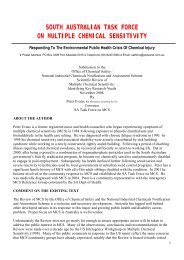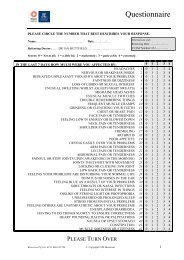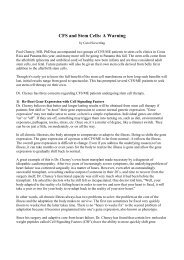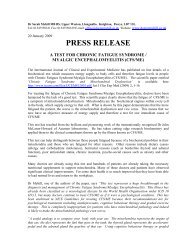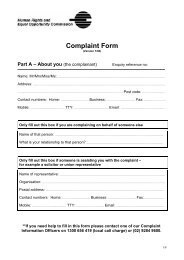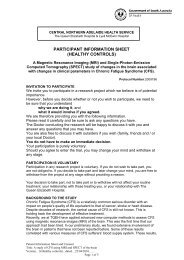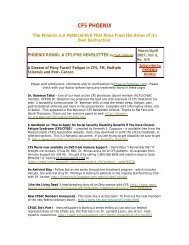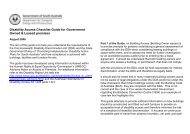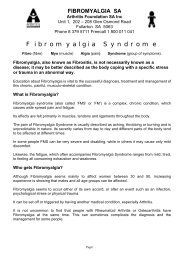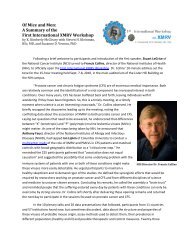62 R. Casale et al.definition of “balneotherapy” has been used onlyto define treatments with thermal or mineral waters,while the definition of hydrotherapy was reservedfor water therapy without particular thermal ormineral contents. More recently, the definition ofbalneotherapy has been applied to all therapeuticprocedures performed in water. This placed balneotherapymidway between physical therapy andcognitive behavioural therapy in as much as theenvironment (thermal resorts), the water temperature(37°C) and the execution of exercise can contributeto the positive results of this treatment inFM. The exact amount of efficacy of each singlecomponent has been challenged by a recent studyin which balneotherapy alone and balneotherapyplus water exercise did not differ in results (34). Torender evaluation more difficult, exercise in waterversus a dry environment does not result in substantialdifferences (35). Positive results can be perceivedafter 6 weeks to 6 months according to differentauthors (36-38). Sauna and mud bath treatmentshave been used with some positive results inuncontrolled studies; these results may be relatedto some sort of stress induced analgesia (39, 40).MOVE<strong>ME</strong>NT AND EXERCISESThe majority of FM patients complain of severefunctional limitations in activities of daily living(41), and not surprisingly, most FM patients arephysically deconditioned (42). Active as well aspassive mobilization have been used although recentreviews do not provide clear results on theirefficacy. Active physical exercise, both aerobic andanaerobic, has been identified as one of the pivotaltreatments in FM, although patients quite oftenhave difficulties in starting and maintaining exerciseprograms (43).The internet provides access to so many types ofphysical training and exercises that is almost impossibleto take all them into account. Moreover,sometimes terms such as “movement” or “physicalexercise” are proposed without giving any specificsconcerning the type of exercise that should be done,the duration, or the intensity of the training. In thisrespect the term physical exercise is similar to theterm “drug”.In both cases describing a treatment as aerobic oranaerobic or drug is not enough, specific details ofthe treatment must be provided. A very recentmeta-analysis reviewed all studies that were identifiedon the Cochrane Central Register for ControlledTrials up to July 2005 suggesting moderateevidence that aerobic-only exercise training atAmerican College of Sports Medicine (ACSM)-recommended intensity levels has positive effectson global well-being and physical function, primarily,and, also a possible effect on pain and tenderpoints. Strength and flexibility remain underevaluated;however, strength training may have apositive effect on FM symptoms. This meta-analysissuggests that aerobic-only training has beneficialeffects on physical function and some FMsymptoms.Strength-only training may improve FM symptoms,but requires further study (44). Table I providesan overview of data from the Cochrane Reviewon exercise for FM (45). However, data on thelong-term efficacy of movement and exercise incontrolling the clinical picture are still lacking.Aerobic exercises can be performed in a traditional“dry” environment as well as in water via deepwater running programs, hydrokinesis therapy inheated water, and in the Spa environment (35, 46,47). In general, both aerobic and anaerobic exerciseshave been associated with educational andoccupational programs (48-52). While the shorttermefficacy of exercise is generally accepted, thecritical issue appears to be long-term compliance.Most studies report a lack of persistent effects associatedwith a failure to maintain the exercise program(53).Passive movements induced by manipulative techniqueshave been also used. They encompass severalmethodologies such as vertebral manipulations,finger pressure on trigger points, craniosacralmanipulation techniques and other forms of chiropractics.A controlled study on the efficacy of chiropracticshas shown a reduction in pain and disability levelsassessed using the Oswestry Pain Disability Indexand Neck Disability Index. Although positive, theseresults should be considered with caution and ageneralization of the efficacy of these practices isuntenable (54). Stretch and spray technique is apopular form of myofascial pain therapy in rehabilitation.The technique combines the effect of rapid coolingof the overlying skin using a vapocoolant such asfluorimethane with passive elongation of muscles.Despite its popularity only one study reports a reductionof pain at the trigger points measured bypressure algometer and VAS in myofascial pain patients;as far as we know no data are available onFM patients.
Non pharmacological treatments in fibromyalgia 63Table I - Major findings of Cochrane revision on “Exercise for treating fibromyalgia syndrome” from: Busch AJ, Barber KAR, Overend TJ, PelosoPMJ, Schachter CL. Exercise for treating fibromyalgia syndrome. Cochrane Database of Systematic Reviews 2002, Issue 3.Aerobic 4 studies Aerobic fitness/performance improved on average by 17% in patients who did aerobicexercise cycling, walking, exercises and 0.5% in patients who did notwhole body- thresholds to pain improved on average by 28% in patients who did aerobic exercisesor dance aerobics but worsened by 7% in patients who did notover 6 to 20 weeks - pain intensity decreased on average by 11% in patients who did aerobic exercises(2 studies tested but increased by 1.6% in patients who did notat 2 or 4.5 years - overall well-being improved in patients who did aerobic exercisesalso).- sleep, fatigue, sense of well-being, confidence in performing tasks and physical functionimproved in some studies but did not in other studies- psychological function, such as depression or anxiety, improved equally in patientswho exercised and in patients who did notStrength One study - pain, muscle fitness and mood improved in patients who did strength exercises more thanexercises squats, knee in patients who did notand trunk extensions - sleep and fatigue changed about equally in patients who exercised and in patientsand bench presswho did notover 21 weeksCombined One study - aerobic fitness and thresholds to pain improved more in patients who had a combinedexercises Aerobic program exercise program compared to patients who did not(walking) strengthand flexibilityexercisesover 6 weeksCombination Two studies - there were no differences between the patients who exercised with biofeedback or withoutof exercise Aerobic exercise biofeedbackand another plus educationtreatment and aerobic exerciseplus biofeedbackLonger Three studies that - One study showed that patients reported better physical function and greater confidencefollow-up tested exercises for in performing daily tasks after 1 year of exercise.longer than 21 weeks - The other study showed that patients who exercised for 6 months had greater confidencein performing daily tasks, had less fatigue and showed more improvement in the 6-minuteCOGNITIVE BEHAVIORAL THERAPYAlong with physical exercise training, cognitive behavioraltherapy is a recognized treatment for FM.Cognitive behavioral therapy (CBT) is a compositeof two approaches, cognitive therapy and behavioraltherapy. Today CBT refers to a large numberof component methods. The term CBT is nonspecificand similar to the term “drug”. Similar tothe generic term “physical exercise” discussedabove, describing a treatment as CBT or drug is notenough, specific details of the treatment must beprovided.The behavior therapy component of CBT includesa number of techniques that are centered on thecore tenants of operant and classical conditioningin psychology. In applications to treatment, theclassification is expanded to a number of methodsthat include relaxation, sleep hygiene, pacing ofactivity, scheduling social and leisure activities,pain coping, education, and assertiveness training(55). The combination of this large group of proceduresalong with cognitive therapy provides thecomponents of the CBT “toolbox”. This concept ofa toolbox is important when considering CBT forFM patients since meaningful discussion and evaluationmust take into account the specific tools thatare used.Co-morbidities including stiffness, fatigue; andproblems with sleep, concentration and memory
- Page 2 and 3:
2 P. Sarzi-Puttini et al.The meetin
- Page 4 and 5:
4 M. Cazzola et al.(2). In the earl
- Page 6 and 7:
6 M. Cazzola et al.enough to meet F
- Page 8 and 9:
8 M. Cazzola et al.Table I - Charac
- Page 10 and 11:
10 M. Cazzola et al.Table IV - Cond
- Page 12 and 13: 12 M. Cazzola et al.teria, three su
- Page 14 and 15: 14 M. Cazzola et al.tients with a n
- Page 16 and 17: 16 G. Cassisi et al.The cardinal fe
- Page 18 and 19: 18 G. Cassisi et al.StiffnessIn FM
- Page 20 and 21: 20 G. Cassisi et al.Autonomic and n
- Page 22 and 23: 22 G. Cassisi et al.Associated symp
- Page 24 and 25: 24 G. Cassisi et al.46. Coleman RM,
- Page 26 and 27: 26 S. Stisi et al.sensitization,”
- Page 28 and 29: 28 S. Stisi et al.Sum oflife-events
- Page 30 and 31: 30 S. Stisi et al.trols, they prese
- Page 32 and 33: 32 S. Stisi et al.stress, obtained,
- Page 34 and 35: 34 S. Stisi et al.50. Harris RE, Cl
- Page 36 and 37: ORIGINAL ARTICLEReumatismo, 2008; 6
- Page 38 and 39: 38 F. Atzeni et al.lalanine (17), a
- Page 40 and 41: 40 F. Atzeni et al.clearer and it m
- Page 42 and 43: 42 F. Atzeni et al.healthy control
- Page 44 and 45: 44 F. Atzeni et al.and/or verbal (e
- Page 46 and 47: 46 F. Atzeni et al.for study purpos
- Page 48 and 49: 48 F. Atzeni et al.mimics of fibrom
- Page 50 and 51: ORIGINAL ARTICLEReumatismo, 2008; 6
- Page 52 and 53: 52 P. Sarzi-Puttini et al.A larger
- Page 54 and 55: 54 P. Sarzi-Puttini et al.from 1966
- Page 56 and 57: 56 P. Sarzi-Puttini et al.rational,
- Page 58 and 59: 58 P. Sarzi-Puttini et al.49. Toffe
- Page 60 and 61: 60 R. Casale et al.cal exercise and
- Page 64 and 65: 64 R. Casale et al.are more or less
- Page 66 and 67: 66 R. Casale et al.trol associated
- Page 68 and 69: 68 R. Casale et al.32. Lewit K. The
- Page 70 and 71: ORIGINAL ARTICLEReumatismo, 2008; 6
- Page 72 and 73: 72 L. Altomonte et al.In a clinical
- Page 74 and 75: 74 L. Altomonte et al.Table II - We
- Page 76 and 77: 76 L. Altomonte et al.treatments de



